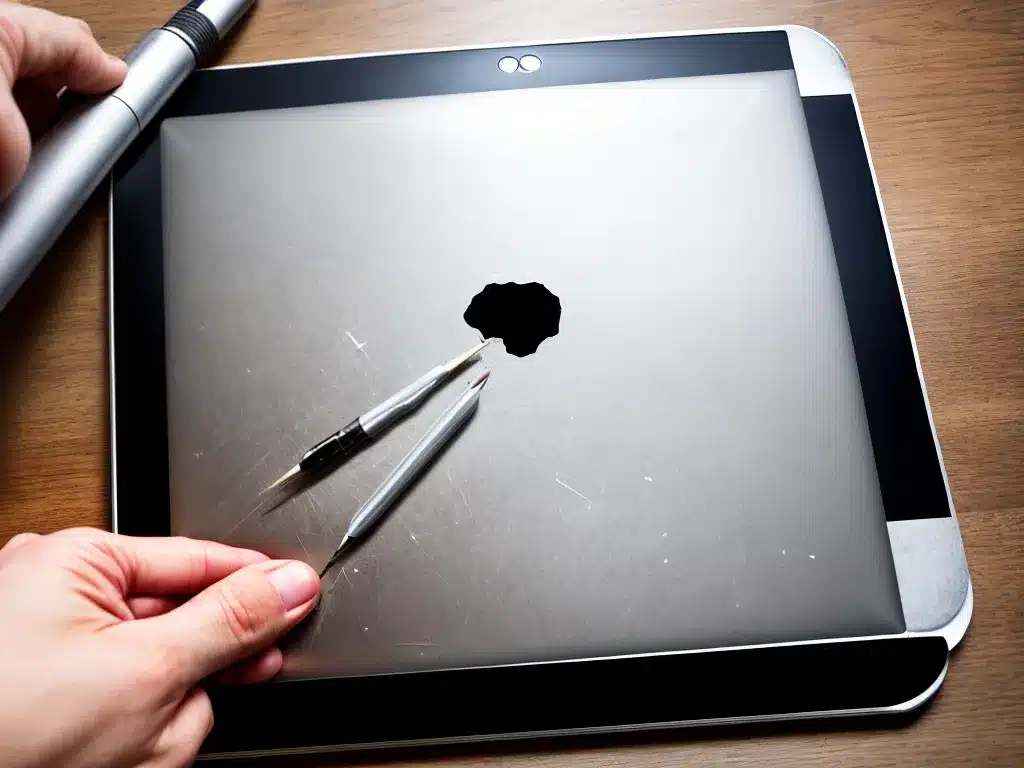Assessing the Damage
When I first noticed a crack on my laptop screen, I panicked. A cracked screen often means an expensive repair bill or buying a new laptop altogether. However, with some patience and the right tools, fixing a cracked laptop screen is possible to do yourself.
The first step is to assess the extent of the damage. Small cracks or chips on the outer glass layer covering the LCD display are relatively easy to repair. Larger cracks that penetrate deeper or cause the LCD display to become damaged or stop working properly often require full display replacement.
To evaluate the crack, I do the following:
- Carefully examine the length and depth of the crack. Short, superficial cracks are the easiest to repair. Long, deep cracks that penetrate the LCD layers are more difficult.
- Check if the LCD still works properly. Turn on the laptop and verify there are no blurred or distorted areas around the crack. If the LCD works fine, the inner layers are likely undamaged.
- Determine if replacement glass is available. For many laptop models, replacement glass or full LCD assemblies can be ordered online. Knowing availability ahead of time is key.
If the crack is large or the LCD functionality seems compromised, I consider taking it to a professional repair shop instead. But for small cracks with LCD functionality intact, a DIY repair is feasible.
Gathering Necessary Materials
Once I’ve determined that I can repair the cracked laptop screen myself, I gather the necessary materials and tools:
- Replacement glass screen cover – I search online to find the right part for my laptop model. Most cost $20-$60.
- Precision screwdriver set – To remove laptop bezel and screen mounting screws. A basic electronics kit works.
- Plastic spudger tools – To pry up the bezel carefully without damaging plastic clips. A credit card or guitar pick can also work.
- Masking tape – To hold glass shards in place during repair. Standard household tape is fine.
- Isopropyl alcohol and microfiber cloth – To clean LCD before re-assembly. 70% isopropyl alcohol is preferred.
I also make sure to work on a clean, well-lit desk and have a container ready to hold any glass shards that come loose during disassembly. With the right tools assembled, I’m ready to get started.
Disassembling the Laptop
The key to fixing a cracked laptop screen is carefully disassembling the bezel and frame to access the damaged glass panel. Here are the general steps I follow:
Removing the Bezel
- Disconnect AC power and remove battery – This avoids electric shock and allows full bezel removal.
- Followedges of bezel – Using plastic tools, I gently pry up and work around the perimeter of the bezel. This releases the plastic clips securing it.
- Detach any antenna leads or cables – Ribbon cables for wifi or webcams will need disconnection before the bezel comes free.
Removing the Damaged Glass
- Take photos for reassembly – I take pictures focused on cable routing and screw hole locations. This helps greatly during reassembly.
- Remove mounting screws – Precision screwdrivers allow removing remaining screws holding the LCD in the frame.
- Lift out old glass panel – I lift out the glass piece by piece if shattered, or in one piece if possible.
By disassembling methodically and keeping track of component locations with photos, I’m able to access the damaged glass panel while minimizing risk of component damage.
Installing the Replacement Screen
Once the cracked glass panel is removed, I thoroughly clean the LCD with isopropyl alcohol and install the new replacement glass. The key steps are:
- Wipe down LCD with alcohol – It’s important no glass shards are left on the display to interfere with the new glass.
- Place new glass over LCD – I take care aligning it and ensuring no debris is trapped between surfaces.
- Secure glass with mounting screws – Re-installing any brackets or screws holds the glass firmly in place.
- Reconnect cables and re-seat bezel – Snapping the bezel back into place secures the glass at the edges.
I take things slowly and double check alignment. It may take a few tries to get the bezel seated correctly with all clips secured. But once assembled, my patience is rewarded with a smooth, crack-free laptop screen!
Testing and Next Steps
With the new screen installed, the last thing I do is power the laptop on and thoroughly test display function. If any issues arise, I recheck connections and alignment. Some additional tips include:
- Update laptop video drivers if available – This ensures best compatibility with the new display.
- Adjust display settings – Brightness, resolution, and other settings may need tweaking.
- Check over several days – Use the laptop normally and verify the repair holds solid.
In many cases, the replacement screen works flawlessly and brings my laptop back to life! However, if issues crop up or the repair doesn’t hold, then it’s best to consult a professional service for a more advanced screen replacement.
While daunting, fixing a cracked laptop display yourself is very doable with some care and patience. By taking things slow and leveraging the right tools and parts, I’m able to save hundreds of dollars and get back to enjoying my laptop again!












